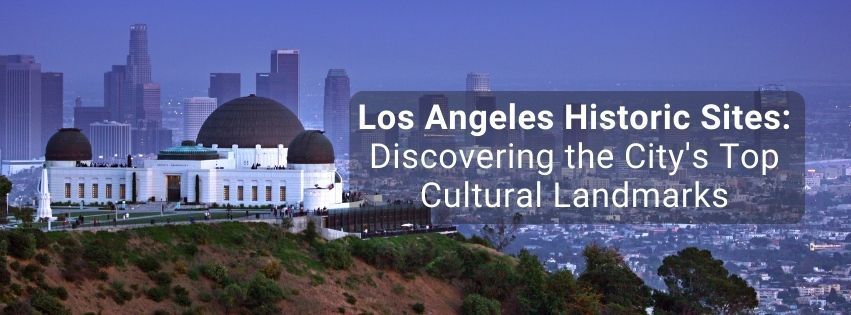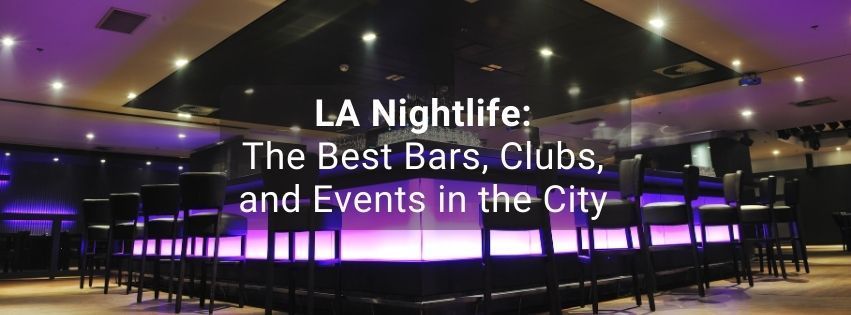Los Angeles Historic Sites: Discovering the City's Top Cultural Landmarks

Los Angeles is a city rich with historical landmarks, each telling a story of its development from a small settlement to the sprawling metropolis it is today. What brief history we have is diverse and dynamic. From the iconic Hollywood sign to the Watts Towers, an impressive display of 20th-century folk art, the city offers a myriad of historic places that attract both tourists and residents alike.
Preserving Los Angeles's historical sites provides tangible connections to the past and offers educational insights into the events and people that shaped the region. Institutions like the Los Angeles Conservancy protect and promote the county's rich architectural and cultural heritage. Through their efforts, and the designation of areas like the Broadway Historic Theatre District, the past is kept alive in the heart of modern Los Angeles. Many of our apartment buildings at Urban LA are just steps away from these historic sites.
Exploring historic sites in Los Angeles is easily accessible by resources such as HistoricPlacesLA, which documents both designated and potentially eligible historic resources throughout the city. Such tools enable locals and visitors to discover the diverse architectural styles, landmark bridges, significant landscapes, and pivotal areas of social importance that contribute to Los Angeles' unique character.
Historic Theaters
Los Angeles' historic theaters are architectural and cultural gems, offering a window into the city's glamorous past. Each theater has its own unique history and influence on the entertainment industry.
Grauman's Chinese Theatre
The Grauman's Chinese Theatre, known for its striking façade, is a cultural icon that opened in 1927. It has hosted numerous star-studded movie premieres and is famous for the celebrity handprints and footprints in its forecourt.
El Capitan Theatre
Opened in 1926, the El Capitan Theatre stands as a testament to the opulence of Hollywood's Golden Age. Today, it operates as a venue for Disney film premieres and events and retains its historic grandeur.
Orpheum Theatre
The Orpheum Theatre is one of LA's most venerable performance spaces. Since its opening in 1926, it has hosted a variety of acts and events, from vaudeville to film screenings and concerts, contributing significantly to the Broadway Theater District's cultural landscape.
Museums and Cultural Institutions
Los Angeles boasts an array of cultural beacons that chronicle human history, creativity, and the natural world. The city's museums are custodians of collective memory and artistic expression, welcoming visitors to explore their diverse and rich collections.
The Getty Villa
Location: Pacific Palisades
Highlights:
- Antiquities Collection: This repository of art features Greek, Roman, and Etruscan artifacts that span 7,000 years.
- Architecture and Gardens: The Villa is designed after the Villa of the Papyri at Herculaneum, encapsulating ancient Roman architecture complemented by lush gardens.
This venue is free to attend, but you have to purchase a parking pass. It’s worth the drive and the paid parking!
Los Angeles County Museum of Art
Location: Wilshire Boulevard
Highlights:
- Diverse Art Collections: It houses an expansive collection that represents Los Angeles's cultural melting pot, with pieces from across the globe.
- Exhibitions and Public Programs: Engages the community with dynamic exhibitions and public programs that foster an appreciation for the arts.
Natural History Museum of Los Angeles County
Location: Exposition Park
Highlights:
- Dinosaur Hall: They are known for an impressive Dinosaur Hall with over 300 real fossils and 20 complete skeletons.
- Nature Gardens: An outdoor exhibit that invites visitors to explore Southern California's flora and fauna.
Historic Districts
Los Angeles boasts various historic districts that capture the essence of the city's diverse architectural and cultural history. Each district offers a window into the past, from the birthplace of Los Angeles to Victorian elegance and urban transformation.
Olvera Street
Olvera Street, known as the birthplace of Los Angeles, is a vibrant Mexican marketplace that represents the city's early multicultural roots. It forms part of the larger El Pueblo de Los Angeles Historic Monument and features the Avila Adobe, the oldest standing residence within the city.
Koreatown
Koreatown, one of the most densely populated districts in Los Angeles, seamlessly weaves together historic charm and modern vitality. Established in the early 20th century by Korean immigrants, this neighborhood has grown from a modest enclave to a bustling urban hub, showcasing the diversity of Los Angeles's cultural landscape. Its architectural diversity, from Art Deco gems like The Victoria to contemporary high-rises, mirrors the area's evolution and the multicultural influences that shape it.
The 1992 Los Angeles Riots were a pivotal moment for Koreatown, underscoring its challenges and resilience. The community's efforts to rebuild in the aftermath have led to a remarkable transformation, solidifying Koreatown's role in the city's urban narrative. Today, it is celebrated for its blend of traditional Korean eateries, trendy cafes, and entertainment venues, standing as a testament to cultural preservation, innovation, and the power of community unity. View our Koreatown buildings to see what living in this tight knit community would look like.
Angelino Heights
Angelino Heights stands out for its immaculately preserved Victorian homes, making it one of Los Angeles's most picturesque neighborhoods. Visitors can stroll through the streets to observe stunning examples of Queen Anne and Eastlake Victorian architectural styles.
DTLA
Downtown Los Angeles (DTLA) serves as the historical heart and soul of the city, tracing its origins back to the founding of Los Angeles in 1781. Over the centuries, DTLA has transformed from a modest pueblo to the bustling metropolis's central business district, embodying the city's economic growth and cultural evolution. The area is renowned for its architectural landmarks, including the iconic Union Station and the historic Broadway Theater District, which capture the essence of Los Angeles' diverse architectural heritage. You can visit The Judson to see what an old warehouse has to offer.
DTLA's revitalization efforts in the 21st century have reinvigorated the area, turning it into a vibrant hub of arts, culture, and nightlife. This resurgence has not only preserved its rich history but also set the stage for a future where tradition and modernity coalesce, making Downtown LA a pivotal chapter in the ongoing story of Los Angeles.
Bunker Hill
Once home to the city's wealthy elite, Bunker Hill underwent significant redevelopment in the 1960s. It now offers a mix of modern skyscrapers and cultural venues, yet remnants of its opulent past, such as the Angels Flight railway, can still be seen.
Hollywood
Hollywood, California, stands as an emblem of the entertainment industry, its name synonymous with cinema and celebrity. Its journey from a small community in the early 20th century to the global epicenter of film and television is a testament to its monumental impact on culture and entertainment worldwide. Hollywood's historical landmarks, such as the iconic Hollywood Sign and the Walk of Fame, serve as enduring symbols of dreams and creativity. The district was pivotal in the development of the film industry, hosting the first film studio in 1911, which laid the groundwork for what would become an unparalleled cinematic empire.
Over the decades, Hollywood has continued to evolve, embracing new technologies and storytelling methods, while its rich history remains a beacon for aspiring artists and filmmakers around the globe. Hollywood's legacy is not just in its contribution to entertainment but in its enduring role as a land of opportunity and imagination.
Landmark Buildings
Los Angeles is home to several architectural marvels that offer a glimpse into the city's rich history and cultural significance. These landmark buildings are not only iconic sights but also narrative tapestries of the city's development.
Bradbury Building
The Bradbury Building stands as a testament to Los Angeles' architectural heritage. Constructed in 1893, it showcases ornate ironwork and skylit atriums that have made it a favorite for both tourists and filmmakers.
Union Station
Union Station is a prime example of Los Angeles’ historic buildings, merging art deco, mission revival, and streamline moderne styles. Opened in 1939, it's more than a transportation hub; it's a symbol of the city's expansive growth during the early 20th century.
Griffith Observatory
Perched atop Mount Hollywood, the Griffith Observatory is an art deco icon and a gateway to the cosmos, offering unmatched views of Los Angeles and the stars above since its opening in 1935. It serves as both a public observatory and a significant cultural attraction.
Parks and Monuments
Los Angeles is home to a variety of parks and monuments, each with its historical significance and contribution to the cultural tapestry of the city. These landmarks offer a glimpse into the city's past and a chance to appreciate its natural beauty.
Elysian Park
Elysian Park, established in 1886, is not only the oldest park in Los Angeles but also one of the largest, covering over 600 acres. The park provides a vast green space amid the urban landscape and features significant sites such as the Chavez Ravine Arboretum.
Exposition Park
Exposition Park is an important cultural and educational hub. It houses the Los Angeles Memorial Coliseum, a key historic landmark that has hosted two Olympic Games. The park also features museums, gardens, and the iconic Rose Garden, open to the public since 1928.
Hollywood Sign
The Hollywood Sign is perhaps the most iconic landmark of Los Angeles, originally created in 1923 as an advertisement and now a symbol of the entertainment industry. The sign overlooks Hollywood from its vantage point at Mount Lee in Griffith Park.
Bridges and Infrastructure
Los Angeles boasts a wealth of historic bridges, each with its own story and place in the city's evolution. These structures serve as functional infrastructures and symbols of architectural ingenuity.
Los Angeles River Bridges
The Los Angeles River is spanned by a remarkable collection of bridges, harking back to various historical periods. These bridges represent significant achievements in engineering and design. A particularly famous example is the series of historic bridges that connect the diverse communities of the city. There are twenty-seven such structures stretching from the San Fernando Valley all the way to Long Beach, many of which merit recognition on the National Register.
- Notable Bridges Over the LA River:
- Buena Vista Viaduct
- Glendale-Hyperion Bridge
- Figueroa Street Bridge
These bridges carry not only vehicles and pedestrians but also the history and diverse cultural heritage of Los Angeles.
Sixth Street Viaduct
The Sixth Street Viaduct, also known as the Sixth Street Bridge, was a famous cultural icon and a staple in many Hollywood films before its closure in 2016 due to safety concerns. A replacement project, known as the Sixth Street Viaduct Replacement Project, is underway to construct a modern bridge that honors the original's design while ensuring structural integrity. The new design is expected to include arches and access to recreational spaces, mirroring the historic significance of the original structure and its role in Los Angeles's urban landscape.
- Attributes of the New Sixth Street Viaduct:
- Incorporation of ten pairs of lit arches
- Seismic resistance features
- Space for future integration with the proposed park beneath the viaduct
The Sixth Street Viaduct serves as an important connection and has evolved to meet contemporary engineering standards while preserving the memory of Los Angeles’s storied past.
Religious Structures
Los Angeles hosts a diverse collection of historic religious structures, each reflecting the city's rich cultural tapestry and architectural heritage.
Cathedral of Our Lady of the Angels
Cathedral of Our Lady of the Angels serves as the mother church for the Los Angeles Archdiocese. With its completion in 2002, it stands as a modern architectural marvel designed by Spanish architect José Rafael Moneo. The cathedral's distinctive alabaster windows scatter sunlight throughout its interior, offering a serene ambience to its visitors.
Wilshire Boulevard Temple
The Wilshire Boulevard Temple is an emblem of historical and religious significance for Los Angeles' Jewish community. Recognized as a Historic-Cultural Monument and listed in the National Register of Historic Places, this temple is known for its grand Byzantine-Revival style architecture and ornate interior, including a majestic dome and a Warner Bros.-commissioned mural.
Historical Residences
Los Angeles is home to an array of historical residences that offer a window into the city's eclectic architectural heritage.
Hollyhock House
The Hollyhock House, designed by the renowned architect Frank Lloyd Wright, stands as a testament to his contribution to modern architecture. Built between 1919 and 1921 for oil heiress Aline Barnsdall, this residence gets its name from the favorite flower of the owner, which is heavily stylized and incorporated throughout the design.
- Address: 4800 Hollywood Blvd, Los Angeles, CA 90027
- Architectural Style: Mayan Revival, an example of Wright's textile block designs
Wattles Mansion
The Wattles Mansion and Gardens showcase the life of affluent Los Angeles in the early 20th century. Developed in 1907 by wealthy Omaha banker Gurdon Wattles as his winter retreat, the estate originally consisted of 49 acres and represents one of the few remaining examples of this era in Hollywood.
- Address: 1824 N Curson Ave, Los Angeles, CA 90046
- Designation: Listed in the National Register of Historic Places
Understanding and appreciating these historic sites helps cultivate a greater sense of community and fosters an acknowledgment of the collective narratives that define the City of Angels. Plus, it’s cool.
So the next time your friends come to visit from out of town, show off the historical significance of your city by taking them to a few of the places on this list.
Contact Us - Contact Us Footer
We will get back to you as soon as possible.
Please try again later.





